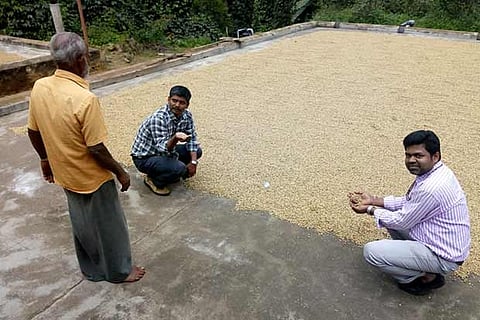

Madurai
Unlike previous year, when Kodaikanal and its surroundings were hit by cyclone Gaja, affecting yield from coffee plants, this year several hilly areas of Kodaikanal experienced copious flow of rain during the northeast monsoon, coffee growers felt.
According to PRM. Ravichandran, secretary, Thandigudi Small Coffee Growers Association, many coffee growers are now upbeat about market prospects. The price of a kilo of coffee beans has now been increased by Rs 40 over the last year. But, its market would surge only when coffee parchments were exported, he said.
However, R. Mahesh, a coffee grower from Kamanur, was aggrieved over the start of the outbreak of leaf rust disease, a fungal attack on coffee leaves. Since the soil turned wet owing to heavy downpour over the last one month, coffee plants mainly Arabica, the most preferred species, became vulnerable to such fungal attack, which caused leaf shedding.
To prevent further spread of the fungal attack, the coffee growers were engaged in spraying fungicide over the coffee plants. But, now the growers had been primarily focusing on harvest season, which could go up to January 15. Not many were engaged in multiple rounds of harvest after being unable to shell out money for the cost of harvest. To be cost-effective, one round of stripping coffee fruit was adopted mostly. Under such method, both cherry coffee (green coffee beans) and ripe fruits would be collected. Normally, the quality of cherry coffee is inferior to parchment coffee, which is gauged as the best quality with its ripe berries, he said.
To improve coffee cup quality, post-harvest technology is necessarily required to adopt, C Babou, Deputy Director (Research) Regional Coffee Research Station of Coffee (RCRSC) Board, Thandigudi, said. Quality of coffee depends on the variety, environmental factors, pest and disease attacks, harvesting and method of processing. Correct process techniques were necessary to prevent deterioration in quality methods of coffee processing in two ways such as parchment or plantation coffee and dry or cherry coffee, the Deputy Director told Dt Next.
Further, Babou said the pre-requisite of good quality coffee is harvesting. The growers need selective harvesting of ripened fruits. They were advised to use picking mat to prevent berries from soil contact and avoid microbial contamination. Each day of harvest should be pulped on the same day to prevent fruity smell. The pulped beans should be covered with mucilage layer, which should be removed completely to obtain good quality coffee. He said the mucilage could be removed by adopting fermentation process at duration from 24 to 36 hours for pulping and clean water is required for washing.
More importantly, drying of coffee is an important stage in processing of coffee. ‘It contributes to the quality of coffee through fermentation of healthy colour, flavour and other quality factors. Wet parchment contains about 50 to 55 per cent moisture, but it has to be brought down to 10.5 to 11 per cent for safe storage. Over drying of coffee leads to loss in out-turn and quality,” he pointed out.
Parchment could be dried on trays, clean tiles, concrete or on brick floors. After adopting these processing methods, moisture content in dried parchment coffee should be bagged in clean jute bag and placed in ventilated store room, the deputy director said.
According to K. Narayanasamy, Deputy Director of Horticulture, Kodaikanal, since coffee plantations were mostly covered with shade trees, coffee plants could not be exposed to sunlight. Hence, a conducive atmosphere needs to be created to allow sunlight to penetrate to keep coffee plants healthy and free of such fungal disease, he said.
While suggesting, Babou, said lopping of shade trees on plantation sites should be done at regular intervals so as to ensure penetration of sunlight. Shade trees that stood above 40 feet need lopping. But, coffee species such as ‘Arabica’ require balanced shade per cent of 40 and 60 per cent shade for ‘Robusta’, he said.
However, V. Ashok, coffee grower from Kodalangadu village near Thandigudi, felt that it was difficult to take permission from the Forest Department for lopping of shade trees.
Visit news.dtnext.in to explore our interactive epaper!
Download the DT Next app for more exciting features!
Click here for iOS
Click here for Android